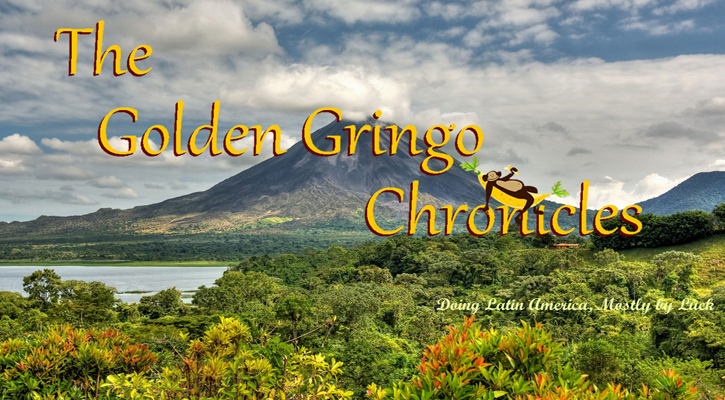

Edition 109 - September 2017
Published at Quepos, Province of Puntarenas, Costa Rica
Publisher: GGC Publications
Editor: Bob Normand, The Golden Gringo, aka "GG"
(©Copyright 2008-2017 All Rights Reserved)
"The mission and goal of the Golden Gringo Chronicles is to provide,
in an
informative and entertaining way, insight into
living
the
Costa Rican
experience as an expat."
1. Broken News: When the Pole Really Did Pop Up to Meet Me; I'm a Pretty New Reptile; Scamming the Canton; Bolivar - Dollar Exchange Rate; El Eclipsito; Brazilian Bottom Bash.
2. Rumble and Weather Talk: Little New on the Shaking Front But the Heavy Rains Continue and So Does the Water Damage
3. Feature: Zarcero Topiary (Never Fire a Good Gardner)
4. Que Es Eso? Department: Look to the Skies (What is it?)
5. Feature: Quepos Qonvenience (Living the Easy Life in a Small Town on the Pacific Coast of Costa Rica)
6. Health Stuff: Coffee Studies Again Positive, More on Centenarians
7. What's-in-a-Word: Answer to Que Es Eso, Etymology of Topiary, A Cachete
8. ROMEO Corner (Anaconda at Costa Verde)
Wisdom of the Ages
|
 |
RECENTLY RELEASED! Mariposa, A Love Story of Costa Rica RECENTLY RELEASED!
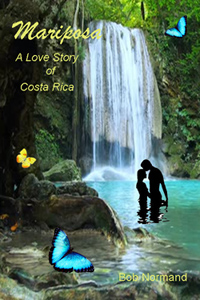 Five hundred years before the Spanish found the American
continent, around the end of the first millennium, Native Americans lived and prospered in Central America, including the land now known as Costa Rica. Truly a natural wonderland then and now, the natives were able to employ their farming skills and prosper from the rich soils, the forests filled with game, herbs, and spices, and the lakes and two oceans rich with fish and crustaceans.
Five hundred years before the Spanish found the American
continent, around the end of the first millennium, Native Americans lived and prospered in Central America, including the land now known as Costa Rica. Truly a natural wonderland then and now, the natives were able to employ their farming skills and prosper from the rich soils, the forests filled with game, herbs, and spices, and the lakes and two oceans rich with fish and crustaceans.
Mariposa, or butterfly, is a story about two young Native Americans, each a favored child of a chief, but of different tribes. These two tribes, historically hostile to each other, lived a few days march apart in the mountains north and east of Costa Rica’s central valley.
The two natives meet by accident, fall in love and begin to plan a life together only to be frustrated by events beyond their control. The lovers are eventually drawn to a mountain volcano which is thought by many to be the home of the gods, particularly Sib'ö, the Great Spirit, who they believe had created the world.
 The story as written incorporates the classic ending of Costa Rica's Legend of Zurqui, one that reflects the beauty, mystery and spirituality that is Costa Rica. Mariposa is available in both English and Spanish versions.
The story as written incorporates the classic ending of Costa Rica's Legend of Zurqui, one that reflects the beauty, mystery and spirituality that is Costa Rica. Mariposa is available in both English and Spanish versions.
Preview the Book (English) on Amazon.com at: Mariposa Preview (This is Chapter 1 in its entirety):
When the Pole Really Did Pop Up to Meet Me
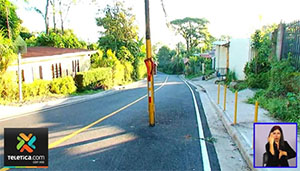 How would you like to come upon the scene to the right while driving down the highway?
How would you like to come upon the scene to the right while driving down the highway?
That's an unadulterated, un-photoshopped picture of a street in the central valley, actually in San Antonio de Escazú, a western suburb of our capital city, San José. The story goes that this pole has been in the same position for some time (like four years) and that even the highway department (MOPT) paved around the pole recently (looks nice, the paving that is...but).
Come on amigos, shouldn't the power company (CNFL) have been asked to move the pole, at least at the time when it was repaved? Whoa GG, step back from the logic, it doesn't work...
I'm a Pretty New Reptile
 Back in December of 2015, the Chronicles featured an article on the reptiles of Costa Rica, especially the snakes, of which there were some 139 species counted at that time. Of these, approximately 22 are known to be venomous or poisonous.
Back in December of 2015, the Chronicles featured an article on the reptiles of Costa Rica, especially the snakes, of which there were some 139 species counted at that time. Of these, approximately 22 are known to be venomous or poisonous.
Whoops, that list (139) didn't last long; we can now add another species. And this one is a sea snake; oh yes we have a number of sea snakes here also. It appears that a hotbed of them exists in the Golfo Dulce (Sweet Gulf) region of Costa Rica (southwest coast). Golfo Dulce is shown on the map to the left bracketed by the Golfito area and the Osa peninsula, the tip of which is not far from Panama. The yellow and black dots shown on the map are GPS sightings of sea snakes identified by university researchers.
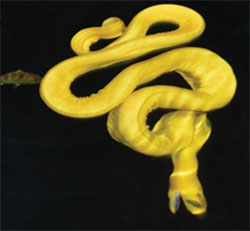 |
| Hydrophis Platurus Xanthos (Xanti) |
When it's not being called a yellow sea snake, the new, solid yellow reptile is designated a Hydrophis Platurus Xanthos. Technically it's a sub-species, not a species according to biologists. The parent species is Hydrophis Platurus (picky-picky, a dude like GG wouldn't know the difference anyway). The yellow dots on the map are the sightings of the new sub-species while the black dots are for the main species.
I'll call him Xanti (now that he's GG's buddy) and he is different from his cousins in two major ways: 1) this dude is bright yellow all over whereas the parent species can have long black lines down its body and 2) its method of hunting is to float most of its body, at night, in a sinusoidal pattern on the wavy surface while dropping its head down into the water to capture small fish. Snap, gotcha!
There was no information given as to whether Xanti was poisonous or not, so I presume it isn't, and anyway, you're unlikely to cross its path unless you find yourself skinny-dipping in the middle of the Golfo Dulce in the middle of the night. I don't know about you but GG doesn't do that anymore, it scares the hell out of the snakes.
Scamming the Canton
As an older dude I'm constantly impressed at how much change in our lives that the advance in electronic technology has produced over the last fifty years.
In the 1960's I thought I was the cat's meow (if you're a millennial, ask your grandfather for the meaning of that phrase please) when I was running the latest IBM computer at the university to support my thesis. Today that computer is suitable only as a museum piece (see Schmaltzing Matilde) and the little box on my desk on which I'm writing this newsletter has a thousand times more capability in both memory and speed.
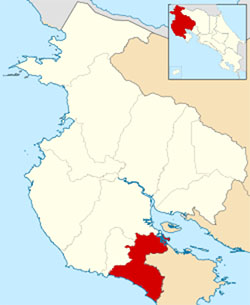 |
| Canton of Nandayure |
But along with the great advances have come risks and dangers. In recent years we've been increasingly subject to fraud and scamming over the telephone and internet. And it's not just limited to individuals. The Canton of Nandayure on the Nicoya peninsula in the province of Guanacaste recently learned that lesson the hard way. Some fraudsters called the Canton office claiming to be from Banco Nacionál, the main bank for government accounts, and were able to convince the Vice-Mayor to give them the Canton's bank account numbers and passwords, ostensibly to update them.
Not long after the call, a wire withdrawal for $132,000 occurred, followed by another one for $37,000 shortly thereafter. A couple of hours later a woman made a personal withdraw of $8,000. By the time the Municipality officers realized what was happening and notified the OIJ (Costa Rican version of the FBI), $177,000 had been lost. Further withdrawals were being attempted while the OIJ traced the transfers but, arriving quickly at the locations where the transfers were being requested they found four perpetrators in their late 20's who were "detained" (that's Costa Rican Spanish for arrested).
Gotta watch your personal account numbers and passwords carefully these days amigos.
Bolivar - Dollar Exchange Rate
These days it's hard not to read the negative news about Venezuela virtually every day. Remember, this is the country that saw some of the first landings of Europeans on the American Continent back in the early 1500's (see History of Colombia - Part Two - The Spanish Period). It also currently holds the largest reserves of oil in the whole world but the economy is collapsing. Unscrupulous, corrupt politicians have brought the country to its knees and a total breakdown is imminent. Some 130 people have been killed in the last couple of months demonstrating against the government, who control the military.
 It was not surprising, therefore, to read that the value of the Bolivar currency, named after the Venezuelan-born liberator of Latin America in the 1800's, reached an all time low in August and spiked as shown on the chart. The "parallel dollar" mentioned on the chart is the black market rate used by virtually everybody including being quoted by Bloomberg. The official rate of 710 bolivars per dollar is considered a joke.
It was not surprising, therefore, to read that the value of the Bolivar currency, named after the Venezuelan-born liberator of Latin America in the 1800's, reached an all time low in August and spiked as shown on the chart. The "parallel dollar" mentioned on the chart is the black market rate used by virtually everybody including being quoted by Bloomberg. The official rate of 710 bolivars per dollar is considered a joke.
This spiking occurred shortly after the government announced it would re-write the constitution to give the current dictator (Maduro) even more power but the short term outlook for recovery and stability is not positive.
God help the people of Venezuela in the coming months.
El Eclipsito
 Just because Costa Rica was not in the direct path of the much hullaballooed solar eclipse didn't mean we were left totally out in the cold (or light, as it may be). We were treated to a partial eclipse.
Just because Costa Rica was not in the direct path of the much hullaballooed solar eclipse didn't mean we were left totally out in the cold (or light, as it may be). We were treated to a partial eclipse.
The photo to the left is the eclipse as seen from the U.S.; actually this one is from the July 22, 2009 eclipse described as "The longest total solar eclipse of the 21st century so far". This photo caught the eclipse in its nearly full phase producing what is described as the diamond ring effect.
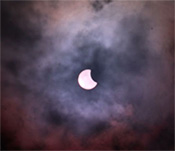 In Costa Rica this time we were treated to only a 20% eclipse as seen in the photo to the right. The photo was taken from the planetary observatory at the University of Costa Rica in downtown San José.
In Costa Rica this time we were treated to only a 20% eclipse as seen in the photo to the right. The photo was taken from the planetary observatory at the University of Costa Rica in downtown San José.
As Latins in general, and Costa Ricans in particular, love diminutive versions of words (they got the name "Ticos" from doing it so much), GG is going to suggest that what we observed on August here in Costa Rica was an eclipsito. A full solar eclipse is not due in Ticoland until October 14, 2023. ¡Pura Luna!
Brazilian Bottom Bash
 |
| Brazilian Miss Bumbum Contest |
Leave it to the Brazilians to come up with an annual pageant which aims to find the best buttocks in the country.
Yes-sir, that's right, the competition of this event, called unsurprisingly Miss Bumbum, is about who has the best female buttocks in Brazil. Some twenty-seven ladies, one from each Brazilian State, are currently in the contest this year (see photo left - and note the handicapped leg on the flag bearer). Fifteen will be selected to enter the final competition on November 6 in Sao Paulo.
As the competition has matured (or immatured, as the case may be) the event has developed pageant standards such as limiting the width of a derrière to 107 cm or 42 inches which, the press took pains to note, eliminated Kim Kardashian’s derrière (109 cm). Kim, baby, you're not keeping up!
 |
| The Chinese Will Copy Anything |
The contest is in its eighth year and has a U.S. American in it for the first time, a former Playboy Model (name undisclosed by the press report). In its short history, the event has become so popular that it has spawned several clones around the world including a Chinese version (photo right).
"The winner of the competition will be awarded a much sought after cover shoot for a popular men’s magazine, a significant cash prize and celebrity status." In addition, previous winners have enjoyed lucrative modeling contracts and endorsements. So ladies. kick butt! (sorry, but GG can't refuse these opportunities). I suppose that, in place of Miss Bumbum it could have been called Miss Tuchas or Miss Heiney.
The Chronicles will endeavor to cover only the most important news stories as they break (well actually, somewhat after they break, that's why it's called Broken News), even if we are bringing up the rear (I told you I couldn't resist this story; it's just too rich with buns...er, excuse, puns).
¡Pura Vida!
 |
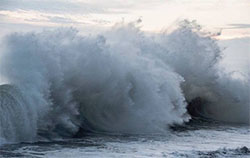 |
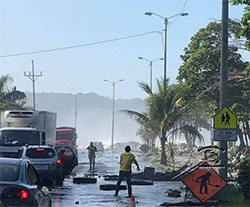 |
| Storm Surge Near Caldera |
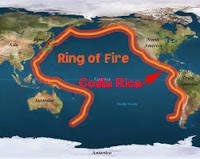 The Pacific Rim, i.e., the string of volcanoes that dissect Costa Rica has, of its own, not been terribly troublesome of late, but three major funnels (Turrialba, Poas, Rincon de la Vieja) continue to percolate. It is highly unlikely that our part of the "Ring of Fire" will ever be totally dormant.
The Pacific Rim, i.e., the string of volcanoes that dissect Costa Rica has, of its own, not been terribly troublesome of late, but three major funnels (Turrialba, Poas, Rincon de la Vieja) continue to percolate. It is highly unlikely that our part of the "Ring of Fire" will ever be totally dormant.
The real news in Costa Rica lately is all about rain. When the hot and dry El Niño weather pattern of the last couple of years gave way to the cooler and much wetter La Niña condition a few months ago many echoed a sigh of relief.
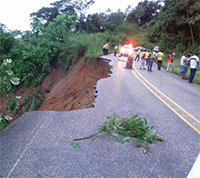 |
| Interamericana Washout |
But it also brought with it a new set of problems. We are only about three months into the rainy season, which runs about seven months from mid-May until mid-December with the worse months being September to November and we've already had more than our share of flooded streams, mud slides and water damage. For example, a part of the Pan American Highway (also known as the Interamericana) recently washed away south of us near Rio Claro (photo left).
We've also had some rough seas. Just a couple of weeks ago near Caldera, an important shipping port near Puntarenas, the coast got hit with tidal waves (see photo above, right). The major highway feeding Puntarenas from Caldera was overcome, despite sizable rock jetties on the seaside of the highway. The flow of transportation was interrupted until the surge receded and the highway department could clean up the mess.
Nothing so far this year seems to have approached the terrific weather violence we had in 2010 (see La Tormenta & Anatomy of a Landslide) which was a fifty-year rain event and which lasted a full six months, but we have plenty of time in the rainy season left this year to challenge that record.
Check Out Recent Earthquakes Around the World Posted by the U.S. Geodetic Survey: Today's Quakes |
Search the Golden Gringo Chronicles Archives for Topics That Interest You
You can use our Archives to search for anything that has been written in more than 220 feature articles of the Golden Gringo Chronicles plus find Broken News items and ROMEO restaurant reviews. Enter your topic or item to search in the Google Search Routine below and follow the links offered from the search results. Suggestion: Enter only a simple, precise and unique as possible keyword or two in order to narrow the number of references retrieved:
Readers: Our publication is open to suggestions regarding future articles and will accept pieces written by others but we reserve the right to decline anything that the editorial staff (that's GG) thinks is inappropriate for this format. Send proposals, comments, suggestions, ideas, meaningless statements and jocular observations concerning the Chronicles to GG here: gg@goldengringo.com.
 One of the things to see in Costa Rica, that happens also to still be on GG's current bucket list, is the town of Zarcero in the province of Alejuela. Zarcero is located in the Canton (county) of Alfaro Ruiz in the province of Alejuela and, as the volcanic ash flies, is only about 45 kilometers northwest of San José (red arrow on the map to the left). By human-controlled, self-propelled vehicle, it's about an hour and a half. This is fertile growing country and many agricultural products from the area proudly proclaim their Zarcero origin, including a truck I always see in Quepos: "La Cosecha de Zarcero" brand ("The Harvest of Zarcero").
One of the things to see in Costa Rica, that happens also to still be on GG's current bucket list, is the town of Zarcero in the province of Alejuela. Zarcero is located in the Canton (county) of Alfaro Ruiz in the province of Alejuela and, as the volcanic ash flies, is only about 45 kilometers northwest of San José (red arrow on the map to the left). By human-controlled, self-propelled vehicle, it's about an hour and a half. This is fertile growing country and many agricultural products from the area proudly proclaim their Zarcero origin, including a truck I always see in Quepos: "La Cosecha de Zarcero" brand ("The Harvest of Zarcero").
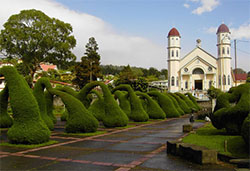 |
| Topiary & Church - Zarcero |
Zarcero is a small town of just over 13,000 people but is home to two very interesting landmarks, the church in the center of town and the topiary (see What-s-in-a-Word section below for the etymology of this word) directly across from the church entrance. The topiary is actually the town's central park and is officially known as the Parque Francisco Alvarado but the park is actually administered by the church parish. Both are shown in the photo to the right. Like many towns throughout the Christian world, one usually finds a church at the center of the town. I found this to be true in Europe when I lived there and it's also true for Latin America, including Costa Rica. Zarcero is stereotypical in that regard.
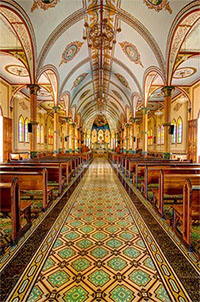 |
| Interior of San Rafael |
The church in question is the Iglesia de San Rafael, which on further study is more like a cathedral. A showplace for the local population, the church's interior is ornately beautiful as shown in the photo to the left. The church was built in 1895 and "features artwork including elaborate pastel stencil work done by Don Misael Solis Alvarado, a local Costa Rican artist".
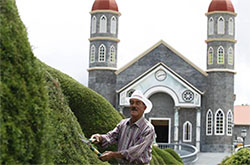 |
| "Tista" (above) and Examples of His Work (below) |
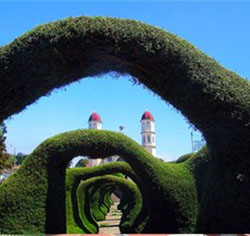 |
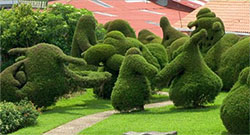 |
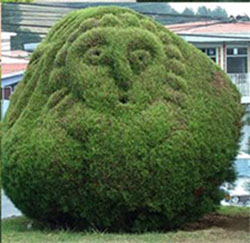 |
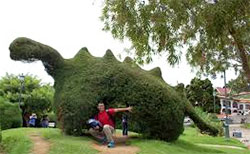 |
The park across the street is a work of art also. In 1964, at the age of 26, the caretaker or curator of the park became one Don Evangelista Blanco, a local gardener. The story is not clear as to why the hiring of a curator for this public park was and is paid for by the Church, but evidently that is the case to this day.
Don Evangelista, who eventually became known by the nickname "Tista", began his reign by planting cypress seeds in a big section of the park. It took about four years before the cypress became large enough to allow significant pruning. At that point Tista got creative and began shaping the young trees into various shapes and forms as seen in the photos to the right. Don Evangelista even became a winner, in 2014, of the National Prize of Popular Culture, of the Ministry of Culture and Youth.
Here's how one reporter described the park: "The human figures are generally squat and jolly, sometimes standing on their own and other times bunched together in groups. There are also carved animals and dinosaurs. Some of the bushes simply have faces etched into their surfaces. One bush was even been shaped into the likeness of Jesus himself in deference to the looming house of the holy. Possibly the most stunning and iconic creations however are the series of green arches that are laid out in rows that create the effect of naturally grown tunnels, through which visitors can stroll." That's a lot of pruning amigo, buen trabajo.
Year by year the park became more elaborate and interesting. Today Tista is 79. He probably expected that he would spend the rest of his days shaping the cypress, but in June of this year he was summarily dismissed by the parish priest (whose name shall go unreported here to save him both embarrassment and potential harm). It's not clear whether the dismissal was a cost saving measure or a humanitarian gesture because of reports that Tista is getting less stable in his balance and weaker in his eyesight (no need to tell GG about that amigo, I understand).
But what neither the church nor Tista were prepared for was the reaction on the part of the Costa Rican populous and the extensive bad press the firing brought. The major newspapers and TV channels picked up the story and blasted it across Costa Rica. The comments and outrage swelled:
"The church’s architecture may be awe inspiring, but the Parque Francisco Alvarado manages to be simply inspiring."
"Without any training in sculpture, Don Evangelista has managed to create a work of art."
"The Ministry of Labor (Ministerio de Trabajo) has launched an investigation into whether or not the firing was legal."
Faced with that kind of public pressure, the Episcopal Conference hierarchy in San José charged an Archbishop, who is also the Bishop of Alejuela, Angel San Casimiro, with solving the problem. He relieved the local priest who fired Tista from parish duties in order that he might "...simply give himself some time to calm down, to reflect and try, on weekends, to help in some neighboring parishes.” (In the business world we call that move a lateral arabesque)
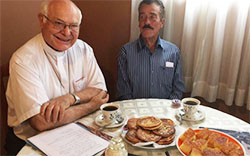 |
| The Archbishop and Tista Having Lunch |
The Archbishop also issued an extensive apology, first on the Episcopal Facebook page, then in a video where he said: “Certainly, life is not about doing things, but knowing how to do them. And in this very case, I think it was not known how to give the news to a man who has dedicated his life to his work. For this, don ‘Tista’ (as Don Evangelista is known locally), I am sorry, I ask for your forgiveness. If it is human to wrong, it is also to apologize and to correct the error.”
Then the Archbishop invited Tista to lunch and apologized personally (press photo of the two together above). For your penance padre, say three Our Fathers, three Hail Marys and pass the Gallo Pinto please.
Part of Don Evangelista's new duties will be to train his replacement(s). Now that's a retirement plan.
¡Pura Vida!

To the left is a distant shot of the crater at Arenal, one of Costa Rica's more famous volcanoes and a tourist hotspot. The steam rising from the other side of the wall is from the overheated crater lake.
Do you see a dot above the crater?
That's the mystery folks, what is it?
Answer in What's-in-a-Word section below.
GG has lived in a number of large, medium and small towns in the U.S., Belgium and now Costa Rica but I must admit a prejudice for small towns. They don't always offer all the "things" and "stuff" that large metropolitan areas often have much more of in abundance but I do find small towns more manageable, more intimate and friendlier. I can always get to the big cities one way or another when I really need stuff.
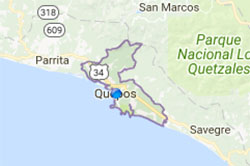 |
| Canton of Quepos |
I now live in Quepos and even if you count Manuel Antonio and the "suburbs" surrounding us, like Inmaculada, Paquita and the small communities along the highway south of us down to the Savegre area, it's hard to come up with more than 10,000 in population. The entire Canton (county) of Quepos encompasses an area of 545 square kilometers or about 210 square miles. Think of a rectangle 21 miles wide by 10 miles deep (the actual shape is shown on the map to the left). The total population of the Canton of Quepos is slightly less than 30,000.
In Quepos downtown you'd be hard pressed to come up with more than 5,000 permanent residents (not including the ever-present, uncountable tourists) in a pueblo essentially five by five blocks. This means, of course, that it's difficult walking around town even for a half hour without running into several people you know. And, of course, you also meet many people you know from Manuel Antonio and the other "burbs". I like that intimacy and I also like the friendly attitude. Walking through Quepos brings on a continuous chorus of "Buenos Dias" or "Como le va?" (How's it going), Solo Bueno! (Only Good!) or A Cachete! (see the meaning of this last phrase in the What's-in-a-Word section below).
I recently wrote an article for International Living Magazine about daily life in a small, Pacific Coast town in Costa Rica. Here's what I wrote:
"I get up between 7:30 and 8 AM, late by some expat standards, but I had hoped for that kind of leisurely start for years and now I have it. Half the time I eat a breakfast consisting of a mixture of freshly processed local fruit such as papaya, mango and pineapple, sprinkled with dried cranberries and topped off with liquid fruit yogurt. On other days, I might meet several expat friends for coffee and breakfast at a local restaurant ($5). These sessions generate close friends and are priceless for the experiences we exchange with each other.
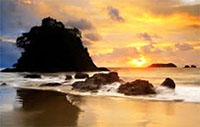 Two or three times a week after breakfast I might go to the main beach in Manuel Antonio by bus, one of the most beautiful and natural beaches I have ever seen (15 minutes - no bus fee for official residents over 65). I spend a couple of hours sitting under an umbrella, reading a book on my Kindle, enjoying the vista and a Pacific breeze and chatting with the beach vendors who pass by. It’s always cooler at the beach than downtown and the ocean is always warm (75-85F). The sunsets are simply spectacular.
Two or three times a week after breakfast I might go to the main beach in Manuel Antonio by bus, one of the most beautiful and natural beaches I have ever seen (15 minutes - no bus fee for official residents over 65). I spend a couple of hours sitting under an umbrella, reading a book on my Kindle, enjoying the vista and a Pacific breeze and chatting with the beach vendors who pass by. It’s always cooler at the beach than downtown and the ocean is always warm (75-85F). The sunsets are simply spectacular.
I walk or take the bus, having decided when I moved here after 50 years of continuous car ownership, that I would give it three months before replacing the car I sold in Florida. I never bought another car. I don’t have a need to get to a job and the buses go everywhere in the country on time. The local buses are free to (official) residents over 65 and seats on the longer hauls, like to San José, are 25% off (e.g., only $6 from Quepos to San José).
And Quepos is very convenient for daily living needs. Here’s an example:
One day recently I left my apartment at 9:05 in the morning and walked three blocks south to the post office to retrieve a letter from my box, then three blocks west to get a haircut from my friendly old barber who claims to have been the first barber in Quepos (I believe him, he's even older than me - $5); then two blocks north to my bank to grab some cash from the ATM. Next I walked another block north to an Italian bakery, enthusiastically violating my low-carb diet with a pastry and some rich, black Costa Rican coffee. Next I walked three blocks north and arrived at my dentist’s office, which was the original reason for being downtown, arriving at 10:05 for a 10:30 appointment. Dr. Alberto waved me in early and completed a filling in fifteen minutes ($50). On the way back home I stopped briefly at the supermarket, arriving home at 10:35 (four stops including a filling: elapsed time 1 hour 30 minutes). And during this trek I was able to exchange pleasantries with four Ticos and another expat, all of whom I know well.
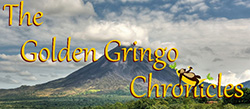 In the afternoon I often spend an hour or two writing a monthly newsletter which I call the Golden Gringo Chronicles (current edition is #107). This evolved from writing periodic email reports back to family and friends when I first arrived here almost nine years ago. One of the unexpected benefits derived from writing the Chronicles is that I had to research an awful lot more about Costa Rica than might have been the case without the Chronicles. It is an enjoyable and useful hobby that now reaches some 1,100+ readers.
In the afternoon I often spend an hour or two writing a monthly newsletter which I call the Golden Gringo Chronicles (current edition is #107). This evolved from writing periodic email reports back to family and friends when I first arrived here almost nine years ago. One of the unexpected benefits derived from writing the Chronicles is that I had to research an awful lot more about Costa Rica than might have been the case without the Chronicles. It is an enjoyable and useful hobby that now reaches some 1,100+ readers.
In the evening I normally prepare my own meal but once or twice a week I meet friends at a local restaurant (less than $10) - being a resort town we have 50-60 good restaurants in the area. I also became a founding member of the ROMEO Group here (Retired Old Men Eating Out) and once a month we visit and review one of the better restaurants (results reported in the Chronicles).
 |
| Kids Training at Futsal |
Following dinner, several times a week I will be a visitor at my neighborhood indoor soccer arena to watch the local young people play. Kids that used to hang out at the arena when they were eight or nine are now teenagers playing with the big guys and they look for “Bop” (me) to be in the stands cheering them on. Such is life in a small beach town in Costa Rica.
It’s not that I don’t ever leave Quepos. To the contrary, I have visited most corners of Costa Rica and seen a lot of the natural treasures that are offered around the country (yet I still have a few places on my bucket list to go to). I have also been to parts of Nicaragua, Panama, Colombia, and Argentina. I love to travel and my next objective is to explore Cartagena in Colombia, one of the original cities on the American continent, having been founded about a hundred years before the British established Jamestown, VA."
Life is good here. Life is easy and there are plenty of places and things to explore in Costa Rica and neighboring countries. ¡Pura Vida!
Nuff said.
¡Solo Bueno!
| Note: The information given in this section is offered as news information only and does not indicate GGC confirmation or denial of the accuracy of the treatment or a recommendation to pursue it, nor can we or do we guarantee the efficacy of the results nor validity of the conclusions proffered.
(How's that for a disclaimer?) |

Coffee Studies Again Positive
A new study from the University of Southern California confirms there is a relationship between coffee consumption and longer lifespan. In this particular study USC researchers looked at data from some 215,000 participants (no, they didn't make a pot-o-joe for all of them) and they also looked across multi-ethnic lines. Here's what they found:
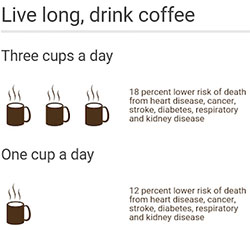 |
| USC Study Findings |
“This study is the largest of its kind and includes minorities who have very different lifestyles,” Setiawan (head researcher) said. “Seeing a similar pattern across different populations gives stronger biological backing to the argument that coffee is good for you whether you are white, African-American, Latino or Asian.” The general conclusions are on the chart to the right.
Furthermore, the researchers went further in their conclusions than previous studies when they said: “Some people worry drinking coffee can be bad for you because it might increase the risk of heart disease, stunt growth or lead to stomach ulcers and heartburn,” Ms. Setiawan said. “But research on coffee has mostly shown no harm to people’s health.”
And GG not only loves coffee (3 cups per day - actually mugs) but he happens to live in the middle of an area with some of the finest tasting coffee in the world (ha, ha, ha , ha, ha, ha, ha, ha, ha, ha , ha, ha, ha).
Here's more on the benefits of drinking coffee: http://www.bobnormand.com/GGC/e82june2015.html#f2.
Last month the Chronicles made note of the recent designation of Costa Rica's Nicoya peninsula by the United Nations as being one of only four "Blue Zones" in the world - a place with an unusually high percentage of centenarians. Since reports first talked about this some months ago, various studies of the hundred-plusers have been and are still are being conducted to see why this is.
Medical records on some 16,300 Costa Ricans pointed towards an exceptionally high average number of people over 100. Some 42 centenarians on the peninsula are currently being studied in detail by geriatricians and other medical experts. Says one research report: "For a 60-year-old Nicoyan male, the probability of becoming centenarian is seven times that of a Japanese male, and his life expectancy is 2.2 years greater. Nicoyans have lower levels of biomarkers of CV (cardiovascular) risk; they are also leaner, taller and suffer fewer disabilities."
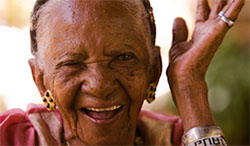 |
| Maria Marchena - 102 Years Young |
According to the study, "the Nicoya diet is prosaic and abundant in traditional foods like rice, beans and animal protein, with low glycemic index and high fibre content." One of the centenarians they interviewed was 102 year old Maria Marchena, "...a single mother who had 12 children. Ms. Marchena prepared the water, removed the placenta, cut the umbilical cord, took care of herself and each of the newborns."
They come tough in these parts, amigos.
¡Pura Vida Larga!

Come on down!
Answer to Que Es Eso?
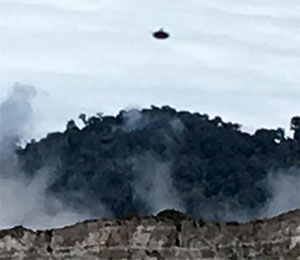
The tourist who shot the steaming Arenal crater photo shown in the Que Es Eso section above claims that the photo to the left is the same shot, only blown up.
In this second photo the dot seems to resolve into a UFO. So now rumor has it there's a secret space visitor camp below Arenal lake (which is often near boiling - too hot even for GG).
Don't these space visitors ever get overheated in places like that? Maybe they got a discount on an air-conditioned room through Trivago, Expedia or Air B&B.
I wonder if there's a good restaurant at the spaceport (just thinking aloud).
Topiary
 Late 16th century: from the French topiaire, from Latin topiarius ‘ornamental gardener,’ from topia opera or ‘fancy gardening,’ from a diminutive of Greek topos ‘place.’
Late 16th century: from the French topiaire, from Latin topiarius ‘ornamental gardener,’ from topia opera or ‘fancy gardening,’ from a diminutive of Greek topos ‘place.’
A Cachete
Cachete, literally translated from the Spanish is "cheek". It can also be used to suggest someone is being cheeky. The term a cachete has taken on the meaning of having full cheeks and the connotation of being in a happy state of being.
Location: About Half a Mile Down the Hill on the Left from the Airplane (El Avion) at the Top of MA Hill.
Hours: Now open for breakfast and lunch ONLY.
Parking: Ample and Private All Around the Restaurant
Contact: Tel.: 011 (506) 2777-0584 or 2777-0187 | US/Canada Toll Free: 1 (866) 854-7958 ; Fax: 011 (506) 2777-0560; Email: reservations@costaverde.com; Website: http://www.costaverde.com/.
Reviewing ROMEOS: Aaron L., Alma L., Jerry C., Bob N.
To Review Our Rating System and Procedure, go here: R.O.M.E.O. Rating System
This restaurant was last reviewed in June of 2012, over five years ago. It's part of the Costa Verde hotel complex that includes El Avion, El Wagon and La Cantina restaurants. Having three of its own restaurants that serve dinner within easy walking distance may be the reason why they chose to change policy along the way to offer just breakfast and lunch.
The dining room has not changed much at all in the last five years. It offers one of the most dramatic views of the Rock Islands of Manuel Antonio off Playa Espadilla, the main beach. The room is open to the atmosphere allowing cool, fresh breezes to pass through. The room is decorated simply but does sport a rather extensive collection of tile mosaics.
Our composite score for ambiance or atmosphere was 5.0 sloths.
The menu was extensive, especially considering the place is open only for breakfast and lunch. It incorporates a fish, chicken and a variety of salads.
GG opted for an Italian sausage sandwich on an Italian roll with french fries. The sausage was particularly flavorful and the french fries were the crispiest and most flavorful that I've had in this area for a long time.
Samplings by other ROMEOs included a chicken ceasar salad, a broiled fish sandwich brochette and chicken nachos. All reports about quality, freshness and flavor were good.
The dessert options were quite limited, namely three flavors of ice cream; vanilla, chocolate and coffee (GG had a combination of the chocolate and coffee).
ROMEO composite score for food quality was 4.79 sloths. |
 |
|---|---|
| $$$$ | |
Value Index=120 |
We were served by two gentlemen (Weiner and Gabriel) who were attentive, helpful and very polite. Our composite score for service was a perfect 5.0 sloths. That brought the composite sloth score for ambiance, food quality and service to 4.79 sloths out of a possible 5.
GG's large sausage sandwich with fries, a coke and the ice cream produced a bill of 8,340 colones (a little over $14 at current exchange rate). The composite score by all four ROMEOs for cost came in at 4.0, yielding a Value Index of 4.79/4.0=120 and putting the Anaconda in the top 1/3 of restaurants currently on our archive list.
The ROMEOs can easily recommended the Anaconda at Costa Verde for good food at a reasonable price (at least for lunch).
¡Pura Vida!
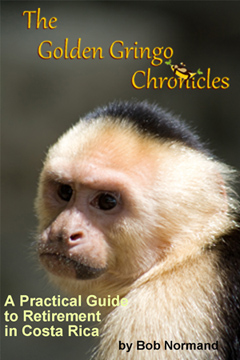 The story of the Golden Gringo Chronicles is also available as a hard copy novel of 192 pages available through Amazon and all major online retailers. ($9.95). Amazon link: GGC, the Book. (Kindle Edition available)
The story of the Golden Gringo Chronicles is also available as a hard copy novel of 192 pages available through Amazon and all major online retailers. ($9.95). Amazon link: GGC, the Book. (Kindle Edition available)
Follow GG through the first six years of his odyssey in making the decision to retire in Costa Rica, overcoming the trials and tribulations of moving and obtaining residency there and the fun and experience of actually living in Ticoland.
Ride along with the Golden Gringo as he learns about the rich, varied culture of Costa Rica, the incredible bio-diversity, the charming nature of the Costa Rican people and the ease with which a sometimes clueless ex-pat can assimilate into a small southwestern town on the Pacific coast.
Whether you are already a Costa Rican resident, someone contemplating a move here or just a traveler who enjoys different cultures, you will find the Golden Gringo Chronicles interesting, entertaining and informative about Costa Rica.
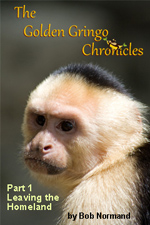 |
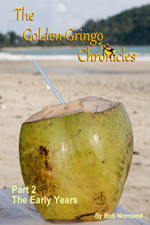 |
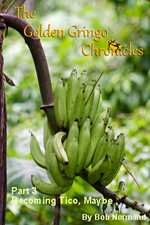 |
| Part 1 | Part 2 | Part 3 |
A narrative version of the Golden Gringo Chronicles is now also available as a trilogy of E-books in formats compatible with virtually all electronic platforms.
Part 1: (FREE!)
Leaving the Homeland
Click on Part Number above for E-book sample downloads or click the price above right for purchase. (The best price is on Part 1; it's FREE)
The Golden Gringo Chronicles is a free newsletter that is non-political, non-commercial and, hopefully, entertaining. By signing up you will receive an email each month around the first of the month giving you the links to the latest edition as well as to each individual feature and departmental section.
CLICK HERE TO SIGN-UP FOR THE
GOLDEN GRINGO CHRONICLES
or Email me at gg@goldengringo.com, and see our Website at: www.goldengringo.com

Bob Normand, Editor & The Golden Gringo
Pura Vida!
To Contact GGC World Headquarters (yuk, yuk) to make comments, suggest topics or criticize my bad jokes, just send an email to: gg@goldengringo.com.
Be pithy but kind; I'm sensitive. (center)
Unsubscribe from Golden Gringo Chronicles